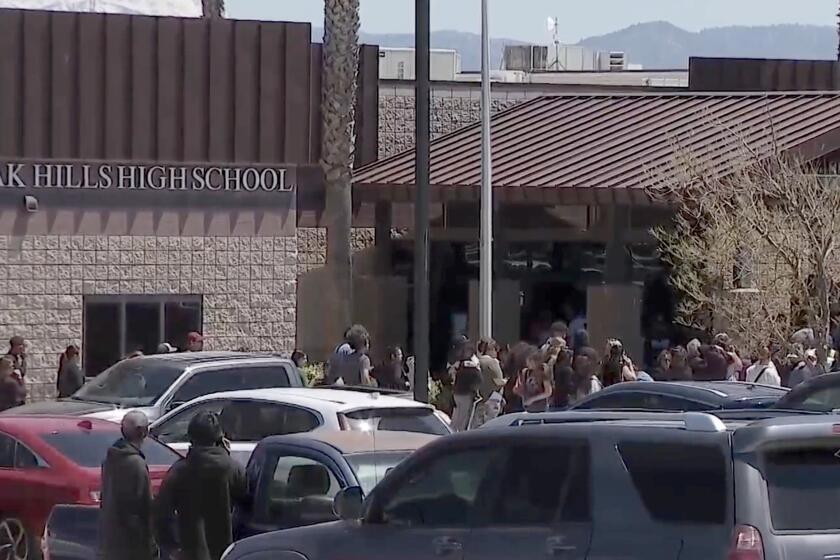Cows versus trout in the Eastern Sierra
In a meadow of knee-high grass framed by rugged granite peaks and pine forests, cattleman John Hunter urged his horse forward along a trail crossing a creek, frowning under a cowboy hat dripping rainwater.
With the summer grazing season in the Eastern Sierra coming to an end, he was preparing, perhaps for the last time, to move hundreds of cows out of the high country and into the Owens Valley. The 30-mile cattle drive from the Golden Trout Wilderness down to the village of Olancha is among the oldest in the state — and a cherished family tradition.
“My grandfather began running cattle in these meadows in 1906,” said Hunter, 47, a third-generation rancher in Lone Pine, about 200 miles north of Los Angeles. “My outfit depends on grazing up here.”
But his right to continue using the land, inside the Inyo National Forest, is dependent on the outcome of a dispute over how best to protect the California golden trout.
Genetically pure strains of the official state fish, with its bright yellow sides, scarlet belly and burnt orange fins, can be found in just 15 miles of streams that run through meadows near Hunter’s grazing land.
A large tract of the 300,000-acre wilderness next to Sequoia National Park has been cow-free since federal land managers in 2001 canceled Anheuser-Busch’s grazing permits in an effort to heal meadows and streams that had been trampled by sheep and cattle since the late 1800s. (One of the world’s largest breweries, Anheuser-Busch had taken over operation of an Owens Valley cattle ranch in 1988.)
Federal officials also “rested” two allotments, totaling 88,000 acres, for 10 years in order to compare their recovery with conditions on two adjacent swaths of land — including that used by Hunter — where grazing was allowed to continue.
With those rests set to expire this year, the U.S. Forest Service is studying three options: extend the experiment, eliminate grazing on all four allotments or forge an agreement with ranchers eager to run cattle over the rested meadows.
“Land management issues are never simple, and this one is going to be long, complicated and controversial,” said Margaret Wood, district ranger for the White Mountain and Mt. Whitney ranger districts of Inyo National Forest. “I hope to make a final decision next year. It will be based on the best available science.”
Data analyzed thus far show that the rested allotments have recovered faster than the grazed ones. But David Herbst, a biologist with the Sierra Nevada Aquatic Research Laboratory, said he believes “grazing would be appropriate in some cases if it were managed under new strategies that, for example, allowed grazing for a year, then rested the land for two to four years.”
Many environmentalists and ranchers, however, seem unwilling to entertain a compromise.
For decades, activists have been trying to protect the golden trout — a candidate for listing as an endangered species — from a variety of threats: livestock grazing, predation by nonnative brown trout and hybridization with stocked rainbow trout. They predict a better future for the wilderness and the trout once cows are driven off.
“I want the wilderness to stay cow-free forever,” said Todd Shuman, a Sierra Club member. “Cows are not wild. They don’t belong in a wilderness. They are a weedy species — exotic, invasive and destructive.”
But ranchers insist that grazing is compatible with high-country ecosystems.
“Nobody understands these meadowlands better than we do,” Hunter said. “And these days, we’re using grazing strategies that are less intensive and promote better range stewardship.”
Three local families, including Hunter’s, have permits to graze a total of 885 cows on the Kern Plateau. They pay $1.35 a month per cow, a rate that has not changed much in four decades. The calves running alongside their mothers are not counted.
The ranchers acknowledge that elimination of wilderness grazing rights would force them to lay off only a handful of cowboys, and that they would lose a relatively modest portion of their annual incomes.
But the battle over the golden trout, which has pitted ranching culture against natural resources and the Forest Service’s mandate to provide for multiple uses on public lands, has broader implications.
“I’m very nervous about it,” said Tom Talbot, former president of the California Cattlemen’s Assn. “We’re fighting anti-grazing forces throughout the United States. Losing grazing rights in the Eastern Sierra would be a huge symbolic loss for us.”
More to Read
Start your day right
Sign up for Essential California for news, features and recommendations from the L.A. Times and beyond in your inbox six days a week.
You may occasionally receive promotional content from the Los Angeles Times.







